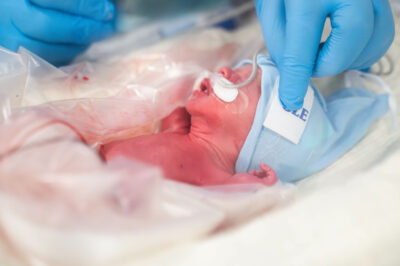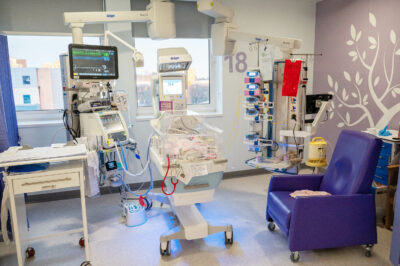
When Amy walked out of her house for a routine 27 week midwife appointment before work on the 23 December, she could never have imagined a scenario where she would only return 3 weeks later, no longer pregnant. Or to this day, that the baby she gave birth to more than ten weeks early, still hasn’t been home. But it’s the reality that Amy and her husband, Gareth, continue to face.
Amy’s pregnancy had been happily uneventful until that December day. So when her blood pressure registered as high and she was told by her midwife to go to hospital for further checks, she was still expecting to be in work with no more than a little story to tell, later that same day. But Amy was diagnosed with pre-eclampsia and told that there was no way she would carry her baby to term. She was admitted for monitoring and reassured by the antenatal team that, while it was still safe for the baby, they would do everything possible to keep her inside.
But only two weeks later, still at only 29 weeks, a scan revealed that the baby was no longer growing and the traces they were running to monitor her heart rate were becoming increasingly irregular. Amy and Gareth were shown around the neonatal intensive care unit (NICU) in preparation and told that their baby would need to be delivered within hours.
Amy said: “I went into a complete state of panic. I just didn’t understand how it could even be possible for a baby to be born this early and survive. I knew that that NICU team had our best interests at heart, but I was in a situation I couldn’t fathom, entrusting my most precious thing to strangers.”

Amy was taken to surgery but while she was being prepared for her caesarian, the monitors could no longer find the baby’s heartbeat and the team went into emergency mode. Reassuringly, baby Freya was born screaming, but she was far from out of the woods. Amy got to see her daughter for a few precious seconds before she was whisked away in a transport incubator with new dad, Gareth, at her side. She weighed just over a kilogram but although incredibly tiny, she was perfect.
When Amy was finally well enough to make it to the NICU a few hours later, she sat next to the incubator for hours, desperate to touch her new baby but too frightened to in case she dislodged one of the countless wires and tubes that were keeping her daughter alive. Amy said: “Freya was on a type of ventilation called CPAP to help her underdeveloped lungs to breathe, was in an incubator to regulate her temperature because she was too small to do it herself, and attached to countless pumps to give her the nutrition she needed. She needed all those pieces of equipment just to do what my body would have done naturally. It just blew me away.”

Despite all the tubes and machines and the shock of her early birth, Freya seemed quite stable at first. Amy and Gareth had been able to hold Freya a few times and though it took two nurses each time to help with the tubes and wires, Amy says that the feeling of holding her new daughter was indescribable.
But it was during one these bonding moments between mother and baby that Amy realised something was wrong.
Amy said: “The sounds and beeps that Freya’s equipment made had started to feel normal and her oxygen monitor would often beep momentarily before Freya’s levels righted themselves again. But on this day the machine started beeping more and more often and her levels were not coming back up. At one point our nurse started having to press the manual breath button to give
Freya more breathing support and I was terrified as she went grey and floppy. There was a rush to get tests done and they came back as sepsis. Freya’s support system was ramped up and all we could do for a week was watch her helplessly, willing her body to fight it off. “
Though Freya gradually recovered from the sepsis, her prematurity made her particularly vulnerable to infection and she fought off several more. She needed two blood transfusions and her underdeveloped lungs had also led to chronic lung disease, which was being made worse the longer she relied on a higher level of breathing support. Freya was put on a course of steroids in the hope of weaning her off CPAP, but when the steroids were stopped she struggled to breathe and her oxygen needed to be increased. Finally, she was put onto a stronger course of medication and was eventually able to cope on a lower level of support. As Freya still wasn’t strong enough to feed on her own, she was being tube fed and struggling to gain weight. Feeding was the next big challenge.

Amy says: “The last stage of NICU before you go home is the nursery where babies are mainly through the woods and just need to grow a bit more. I remember being shown around the nursery in those hours before she was born and despairing at the thought that we’d never get there. But finally we did. Freya still needs to master the knack of feeding on her own and we’ll probably leave with her on oxygen, but thanks to the incredible care she’s received here on NICU, taking her home finally feels real. The whole NICU team have been incredible at supporting us to get here and trying to give us as many “normal” parent experiences as possible.
“Looking back, the level of specialism, technology, medicine and machinery that’s needed to give babies like Freya a chance, still amazes me. It’s not the beginning that we ever would have wanted for our daughter, but it’s thanks to the NICU teams that she got the best start possible and the chance at a future we once feared she wouldn’t have.”







